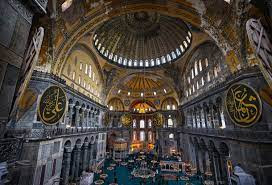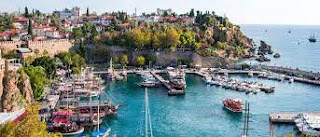1. Hagia Sophia (Aya Sofya) Mosque
Haiga Sophia (Turkish: Ayasofya; Koinē Greek: Ἁγία Σοφία, romanized: Hagía Sophía; Latin: Sancta Sophia, lit. 'Holy Wisdom'), officially known as the Holy Hagia Sophia Grand Mosque (Turkish: Ayasofya-i Kebir Cami-i Şerifi, آياصوفيا كبير جامع شريف), and formerly the Church of Hagia Sophia. (Turkish: Ayasofya Kilisesi; Greek: Ναός της Αγίας του Θεού Σοφίας, romanized: Naós tis Ayías tou Theoú Sofías; Latin: Ecclesia Sanctae Sophiae) is a Late Antique place of worship in Istanbul, designed by the Greek geometers Isidore of Miletus and Anthemius of Tralles.Built in 537 as the patriarchal cathedral of the imperial capital of Constantinople, it was the largest Christian church of the eastern Roman Empire (the Byzantine Empire) and the Eastern Orthodox Church, except during the Latin Empire from 1204 to 1261, when it became the city's Latin Catholic cathedral. In 1453, after the Fall of Constantinople to the Ottoman Empire, it was converted into a mosque. In 1935, the secular Republic of Turkey established it as a museum. In 2020, it was re-converted into a mosque during the administration of President Recep Tayyip Erdoğan. Built by the eastern Roman emperor Justinian I as the Christian cathedral of Constantinople for the state church of the Roman Empire between 532 and 537, the church was then the world's largest interior space and among the first to employ a fully pendentive dome. It is considered the epitome of Byzantine architecture and is said to have "changed the history of architecture".The present Justinianic building was the third church of the same name to occupy the site, as the prior one had been destroyed in the Nika riots. As the episcopal see of the ecumenical patriarch of Constantinople, it remained the world's largest cathedral for nearly a thousand years, until Seville Cathedral was completed in 1520. Beginning with subsequent Byzantine architecture, Hagia Sophia became the paradigmatic Orthodox church form, and its architectural style was emulated by Ottoman mosques a thousand years later.It has been described as "holding a unique position in the Christian world" and as an architectural and cultural icon of Byzantine and Eastern Orthodox civilization. The church was dedicated to the Holy Wisdom, the Logos, the second person of the Trinity.Its patronal feast falls on 25 December (Christmas), the commemoration of the incarnation of the Logos in Christ.Sophia is the Latin transliteration of the Greek word for wisdom, and, although it is sometimes referred to as Sancta Sophia, 'Saint Sophia', it is not related to Sophia the Martyr.The centre of the Eastern Orthodox Church for nearly one thousand years, it was where the excommunication of Patriarch Michael I Cerularius was officially delivered by Humbert of Silva Candida, the envoy of Pope Leo IX in 1054, an act that is commonly considered the start of the East–West Schism. In 1204, it was converted by the Fourth Crusaders to a Latin Catholic cathedral under the Latin Empire, before being restored to the Eastern Orthodox Church upon the return of the Byzantine Empire in 1261. The doge of Venice who led the Fourth Crusade and the 1204 Sack of Constantinople, Enrico Dandolo, was buried in the church. After the Fall of Constantinople to the Ottoman Empire in 1453,it was converted to a mosque by Mehmed the Conqueror. The patriarchate moved to the Church of the Holy Apostles, which became the city's cathedral. Although some parts of the city had fallen into disrepair, the cathedral had been maintained with funds set aside for this purpose, and the Christian cathedral made a strong impression on the new Ottoman rulers who conceived its conversion.The bells, altar, iconostasis, ambo, and baptistery were removed and relics destroyed. The mosaics depicting Jesus, his mother Mary, Christian saints, and angels were eventually destroyed or plastered over.Islamic architectural features were added, such as a minbar (pulpit), four minarets, and a mihrab – a niche indicating the direction of prayer (qibla). It was the principal mosque of Istanbul from its initial conversion until the 1616 construction of the nearby Sultan Ahmed Mosque (the Blue Mosque). The Byzantine architecture of the Hagia Sophia served as inspiration for many other religious buildings including the Hagia Sophia in Thessaloniki, Panagia Ekatontapiliani, the Şehzade Mosque, the Süleymaniye Mosque, the Rüstem Pasha Mosque and the Kılıç Ali Pasha Complex. The complex remained a mosque until 1931, when it was closed to the public for four years. It was re-opened in 1935 as a museum under the secular Republic of Turkey. According to data released by the Ministry of Culture and Tourism, Hagia Sophia was Turkey's most visited tourist attraction in 2015 and 2019. In early July 2020, the Council of State annulled the Cabinet's 1934 decision to establish the museum, revoking the monument's status, and a subsequent decree by Turkish president Recep Tayyip Erdoğan ordered the reclassification of Hagia Sophia as a mosque.[22][23][24] The 1934 decree was ruled to be unlawful under both Ottoman and Turkish law as Hagia Sophia's waqf, endowed by Sultan Mehmed, had designated the site a mosque; proponents of the decision argued the Hagia Sophia was the personal property of the sultan.[25][26][27] This redesignation is controversial, drawing condemnation from the Turkish opposition, UNESCO, the World Council of Churches, the International Association of Byzantine Studies, and many international leaders
2. Cappadocia
Cappadocia (/kæpəˈdoʊʃə/; also Capadocia; Turkish: Kapadokya; Greek: Καππαδοκία Kappadokía, from Old Persian: 𐎣𐎫𐎱𐎬𐎢𐎣 Katpatuka; Hittite: 𒅗𒋫𒁉𒁕 Hatti; Armenian: Կապադովկիա, Գամիրք, romanized: Kapadovkia, Gamirk') is a historical region in Central Anatolia, largely in the Nevşehir, Kayseri, Aksaray, Kırşehir, Sivas and Niğde provinces in Turkey. Since the late 300s BC the name Cappadocia came to be restricted to the inland province (sometimes called Great Cappadocia), Upper Cappadocia, which alone will be the focus of this article. Lower Cappadocia is focused to elsewhere. According to Herodotus,[1] in the time of the Ionian Revolt (499 BC), the Cappadocians were reported as occupying a region from Mount Taurus to the vicinity of the Euxine (Black Sea). Cappadocia, in this sense, was bounded in the south by the chain of the Taurus Mountains that separate it from Cilicia, to the east by the upper Euphrates, to the north by Pontus, and to the west by Lycaonia and eastern Galatia.
3. Topkapı Palace
This article is about the Turkish palace. For the 1964 film, see Topkapi (film). For the neighbourhood in the west of Fatih district in Istanbul, see Topkapı, Fatih. Topkapı Palace Turkish: Topkapı Sarayı Ottoman Turkish: طوپقپو سرايى Topkapı - 01.jpg View of the Topkapı Palace from the Golden Horn Topkapı Palace is located in Istanbul Fatih Topkapı Palace Location in the Fatih district of Istanbul General information Type Royal residence (1478–1853) Accommodation for ranked officers (1853–1924) Museum (1924–present) Architectural style Ottoman, Baroque Location Istanbul, Turkey Coordinates 41°0′46.8″N 28°59′2.4″E Construction started 1465 Client Ottoman sultans Owner Turkish state Technical details Structural system Various low buildings surrounding courtyards, pavilions and gardens Size 592,600 to 700,000 m2 (6,379,000 to 7,535,000 sq ft) Design and construction Architect Mehmed II, Alaüddin, Davud Ağa, Mimar Sinan, Sarkis Balyan[1] Website https://muze.gen.tr/muze-detay/topkapi UNESCO World Heritage Site Part of Historic Areas of Istanbul Criteria Cultural: i, ii, iii, iv Reference 356 Inscription 1985 (9th Session) The Topkapı Palace (Turkish: Topkapı Sarayı;[2] Ottoman Turkish: طوپقپو سرايى, romanized: Ṭopḳapu Sarāyı, lit. 'Cannon Gate Palace'),[3] or the Seraglio,[4] is a large museum in the east of the Fatih district of Istanbul in Turkey. In the 15th and 16th centuries it served as the main residence and administrative headquarters of the Ottoman sultans. Construction, ordered by the Sultan Mehmed the Conqueror, began in 1459, six years after the conquest of Constantinople. Topkapı was originally called the "New Palace" (Yeni Saray or Saray-ı Cedîd-i Âmire) to distinguish it from the Old Palace [tr] (Eski Saray or Sarây-ı Atîk-i Âmire) in Beyazıt Square. It was given the name Topkapı, meaning Cannon Gate, in the 19th century.[5] The complex expanded over the centuries, with major renovations after the 1509 earthquake and the 1665 fire. The palace complex consists of four main courtyards and many smaller buildings. Female members of the Sultan's family lived in the harem, and leading state officials, including the Grand Vizier, held meetings in the Imperial Council building. After the 17th century, Topkapı gradually lost its importance. The sultans of that period preferred to spend more time in their new palaces along the Bosphorus. In 1856 Sultan Abdulmejid I decided to move the court to the newly built Dolmabahçe Palace. Topkapı retained some of its functions, including the imperial treasury, library and mint. After the end of the Ottoman Empire in 1923, a government decree dated April 3, 1924 transformed Topkapı into a museum. Turkey's Ministry of Culture and Tourism now administers the Topkapı Palace Museum. The palace complex has hundreds of rooms and chambers, but only the most important are accessible to the public as of 2020, including the Ottoman Imperial Harem and the treasury, called hazine where the Spoonmaker's Diamond and the Topkapi Dagger are on display. The museum collection also includes Ottoman clothing, weapons, armor, miniatures, religious relics, and illuminated manuscripts such as the Topkapi manuscript. Officials of the ministry as well as armed guards of the Turkish military guard the complex. The Topkapı Palace forms a part the Historic Areas of Istanbul, a group of sites in Istanbul that UNESCO recognised as a World Heritage Site in 1985
4. Antalya
Antalya (Turkish pronunciation: [anˈtalja]; Ancient Greek: Ἀττάλεια) is the fifth-most populous city in Turkey as well as the capital of Antalya Province. [2] Located on Anatolia's southwest coast bordered by the Taurus Mountains, Antalya is the largest Turkish city on the Mediterranean coast outside the Aegean region with over one million people in its metropolitan area.[3][4] The city that is now Antalya was first settled around 200 BC by the Attalid dynasty of Pergamon, which was soon subdued by the Romans. Roman rule saw Antalya thrive, including the construction of several new monuments, such as Hadrian's Gate, and the proliferation of neighboring cities. The city has changed hands several times, including to the Seljuk Sultanate in 1207 and an expanding Ottoman Empire in 1391.[5] Ottoman rule brought relative peace and stability for the next five hundred years. The city was occupied by Italy for three years in the aftermath of World War I, but was recaptured by a newly independent Turkey in the War of Independence. Antalya is Turkey's biggest international sea resort, located on the Turkish Riviera. Large-scale development and governmental funding has promoted tourism. A record 13.6 million tourists passed through the city in 2019.






















0 Comments